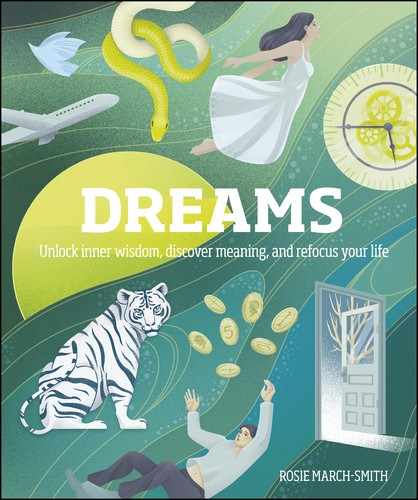
12
WHY DO
WE DREAM?
Scientists do their best to answer this
question, but the fact is no one knows.
They have discovered that we dream
between four and six times a night,
lasting between 5 and 20 minutes a
time, and that everyone has dreams
because they are necessary for our
emotional, mental, and physical health.
In a normal lifespan, we spend no fewer than
6 years dreaming. But what is its purpose?
Researchers write of memory consolidation—of
throwing out the day-to-day waste clogging up
our brain. They claim we dream in order to clear
unnecessary neural connections, making room
for creativity.
They can even tell us how and roughly what
we are dreaming about thanks to the arrival of
brain-imaging machines. But they have still yet
to discover why we dream.
US_012-013_Dreams_Why.indd 12 17/06/2019 16:18

13
Why Do We Dream?
A link to the collective unconscious
Dreams are a conduit to the higher and deeper
realms of the mind. If you imagine an island
with only its hills and peaks showing above the
ocean, it represents symbolically the depth and
width of our unconscious world. Next, imagine
that ocean bed going, as it does, right around
the globe and appreciate how it must connect
with everything. This is the basis for Carl Jung’s
theory of the collective unconscious, where we
are all somehow connected. Psychics say this
linking mind energy lies behind their clairvoyant
ability, privy to the wholeness of our world.
Undoubtedly, quantum physicists are now
coming up with fascinating research into
“outside time,” which could perhaps denitively
lead to an answer to the great mysteries.
Dreams as messages
Most traditional rationalists are at a loss to
explain how it is that people can dream
accurately about their own personal future.
They go weeks without remembering any
nighttime scenario, then suddenly a vivid,
prescient message from the unknown
surprises them.
Dream messages and precognition have
been recorded for thousands of years. Could
we, at some level, be tapping into information
from the collective unconscious, which
also existed for our ancient ancestors, seers,
and prophets?
If the sacred task of dreams is to help us—
without technology’s limitations—to make more
spiritual sense of those hidden realms of the
unconscious, perhaps it is timely to believe
they are nudging us forward in this turbulent
world to a more holistic way of life.
REM AND NREM SLEEP
Using brainwave technology, researchers
discovered that dreaming occurs mainly
during rapid eye movement (REM) behind
closed eyelids. We dream in sleep cycles—
sometimes REM, but also nonrapid eye
movement (NREM), alternating several times
a night. The same may be true of your pets:
Have you noticed they twitch in their sleep,
as if excited or chasing their prey?
Laboratory researchers note a comparable
dreaming state in human volunteers, whose
heads are wired up to measure brainwave
activity, as they move in and out of the
respective cycles. Any emotional responses
to the dream narrative are clearly traced to
synchronize with the electrooculography
(EOG) measure, but technology is unable to
decipher the dream content.
US_012-013_Dreams_Why.indd 13 17/09/2019 16:03
..................Content has been hidden....................
You can't read the all page of ebook, please click here login for view all page.
